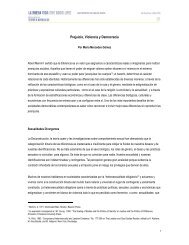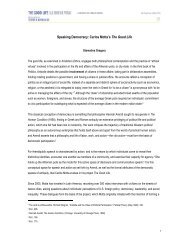Carlos Motta - La buena vida
Carlos Motta - La buena vida
Carlos Motta - La buena vida
Create successful ePaper yourself
Turn your PDF publications into a flip-book with our unique Google optimized e-Paper software.
124<br />
125<br />
would gather as citizens in a local town meeting,<br />
which you could call a general assembly, or<br />
public assembly, or citizens assembly. It is<br />
that body that would be the driving force for<br />
policymaking in society in general.<br />
Chaia Heller, activist and author of “Ecology of<br />
Everyday Life: Rethinking the Desire for Nature”<br />
(1999)<br />
anarchist consensual<br />
democracy<br />
ralf burnicki<br />
transcription excerpt of a video by O. Ressler,<br />
recorded in Bielefeld, Germany, 29 min., 2005<br />
Anarchy is so difficult for people to understand<br />
because many people can’t imagine life without<br />
control, the organs of the state, control from<br />
above. They haven’t learned to develop selfadministered,<br />
organizational structures; they<br />
haven’t learned to realize dominance-free<br />
decision-making, beginning with their private<br />
affairs. Therefore, a certain blind spot exists<br />
in today’s so-called democracy: people are<br />
taught about human rights, Paragraph 1 of the<br />
(German) constitution, “The dignity of man is<br />
inviolable,” espouses concepts that approximate<br />
or correspond to democracy. Yet the everyday<br />
application of what is required of democratic<br />
systems, namely, the population’s actual selfdetermination,<br />
self-administration, and selforganization,<br />
is neglected.<br />
If I want to describe the anarchist principle<br />
or model of consensus, perhaps it is helpful<br />
to first speak of this consensus model as a<br />
theory of independent decision-making or as<br />
a theory of direct democracy. The model refers<br />
to the intrinsic value of political decisions; that<br />
is, the way that a political decision is made is<br />
put at the center of focus. “Consensus” stems<br />
etymologically from the concept of “accordance,”<br />
“agreement.” Consensus, because it should<br />
be free of dominance and refers to an actual<br />
communication and decision-making process,<br />
is important in concrete decision-making. In a<br />
theory of direct democracy, concrete decisionmaking<br />
means, for example, that the agenda<br />
includes questions of how to produce something.<br />
For example: How can we build a center? How can<br />
we build a street? How can we build a collective?<br />
What should we do? Looking at representative<br />
democracy – a democratic form characterized<br />
by representative systems – it becomes clear<br />
that massive numbers of people who are directly<br />
affected by these systems are ignored.<br />
Ralf Burnicki, author of “Anarchismus und<br />
Konsens” (2002)<br />
Oliver Ressler is an artist who is doing projects<br />
on various socio-political themes. Further<br />
information: www.ressler.at<br />
culture and<br />
democracy in<br />
post-revolutionary<br />
mexico and<br />
bolivarian venezuela<br />
tatiana flores<br />
The relationship between culture and democracy<br />
is rarely considered in a long-established and<br />
largely unquestioned democracy like that of the<br />
United States. It is assumed that a democratic<br />
government guarantees freedom of expression;<br />
thus, the nature of culture’s association with<br />
democracy is often left unchallenged except<br />
under circumstances of censorship or situations<br />
that would appear to conflict with civil rights.<br />
Otherwise, culture runs its course separate from<br />
the mechanisms of government.<br />
Communities undergoing social transformations<br />
offer the opportunity to probe our<br />
assumptions on how democracy should address<br />
culture. The establishment of new structures of<br />
government more often than not brings changes<br />
to the cultural sphere. In the paragraphs that<br />
follow, I will look comparatively at two situations<br />
– one past, one present – that have radically<br />
reconsidered the relationship between culture<br />
and democracy: the post-revolutionary period<br />
in Mexico during the 1920s and the Bolivarian<br />
Revolution in contemporary Venezuela. 1<br />
The Mexican Revolution (1910-1920) created<br />
a deep level of social consciousness in the<br />
country’s citizenry. The Constitution of 1917<br />
approached “democracy not only as a legal<br />
structure and a political regimen, but as a<br />
system of life founded on a constant economic,<br />
social, and cultural betterment of the people.” 2<br />
The belief that culture was a right guaranteed by<br />
law drove certain intellectuals and artists of the<br />
post-revolutionary period to envision ways for<br />
art to be universal, although the interpretation<br />
of this concept varied widely. José Vasconcelos,<br />
Minister of Education from 1921 to 1924,<br />
who launched the mural movement and set<br />
up a program of Cultural Missions to spread<br />
education and culture to even the most remote<br />
areas of Mexico, was an aesthete dedicated to<br />
the Western canon. As part of his mandate, he<br />
distributed cheap copies of classical texts to<br />
the poor, oversaw the construction of a stadium<br />
inspired in part by Greek and Roman models,<br />
and set up a network of libraries throughout the<br />
country. Other artists, such as Gabriel Fernández<br />
Ledesma, promoted folk traditions as the most<br />
relevant expressions of art in Mexico and those<br />
most likely to reach a wide audience. He and a<br />
group of contemporaries were leading advocates<br />
for alternative centers of art education – such<br />
as the Open Air Schools of Painting and Popular<br />
Painting Centers – aimed to take artistic<br />
instruction to all sectors of the population,<br />
from the rural peasantry to urban workers.<br />
Another approach to democratizing culture<br />
was in combining art and political activism, as<br />
practiced by Diego Rivera, David Alfaro Siqueiros,<br />
Tina Modotti, and the artists affiliated with<br />
the Popular Graphics’ Workshop. These artists,<br />
1 There is a long-standing debate on whether the<br />
current situation in Venezuela deserves to be called a<br />
revolution. My aim is not to challenge semantics but<br />
rather to compare two moments of political change and<br />
social transformation.<br />
2 “Constitution of Mexico,” Title 1, Chapter 1, Article<br />
3. Emphasis added. Reprinted in http://www.ilstu.edu/<br />
class/hist263/docs/1917const.html. Accessed July 24,<br />
2008.<br />
believing the post-revolutionary government<br />
did not go far enough in instilling radical social<br />
change, were vehement proponents of the<br />
communist cause and assimilated Marxist ideals<br />
into their art and activities.<br />
Post-revolutionary Mexican artists and<br />
intellectuals thus set forth a variety of proposals<br />
on how best to integrate art and democracy.<br />
Despite their good intentions, one of their major<br />
hurdles was that a small elite group presumed<br />
to stand for the majority. For example, peasants<br />
and urban workers were very often the subjects<br />
of modern Mexican art but, except in isolated<br />
cases, did not have the opportunity to speak for<br />
themselves and even less to become significant<br />
contributors to official culture. Their reactions to<br />
seeing themselves depicted in numerous murals,<br />
paintings, and prints (if they ever actually saw<br />
them) are rarely documented, and over time, the<br />
socially conscious aesthetics that drove postrevolutionary<br />
Mexican art became dismissed as<br />
irrelevant to achieving significant social change.<br />
Enter Venezuelan art in the late 1950s.<br />
After decades in which social realism was<br />
the predominant aesthetic in <strong>La</strong>tin America,<br />
Venezuela, along with Brazil and Argentina,<br />
adopted geometric abstraction as the<br />
standard bearer for a new art. Relying on<br />
kinetic and optical effects, artists began to<br />
produce environments and public works that<br />
addressed common sensory experiences in<br />
non-hierarchical ways. Although their formal<br />
explorations followed personal trajectories,<br />
they were united in their belief that contrary to<br />
figuration, geometry could be a universal – and<br />
consequently more egalitarian – visual language.<br />
Eventually, it became clear that this perspective<br />
was also flawed, as geometric abstraction<br />
became associated with corporate aesthetics<br />
and remained very much an elite taste and<br />
sensibility. For the influential art critic Marta<br />
Traba, kinetic art in Venezuela was emblematic<br />
of the government’s disregard for the deeprooted<br />
social problems she witnessed there.<br />
After decades of corruption and worsening<br />
social conditions, Hugo Chávez was elected<br />
president of Venezuela in 1998 and immediately




